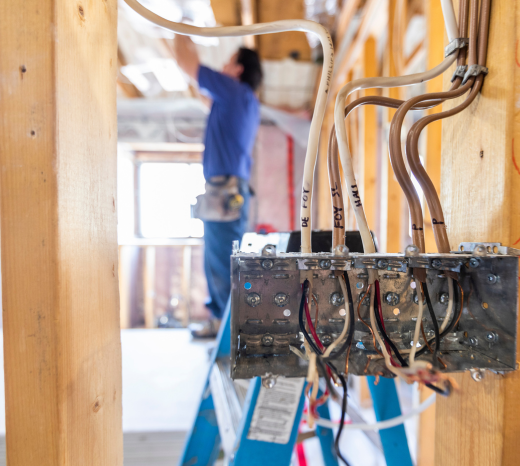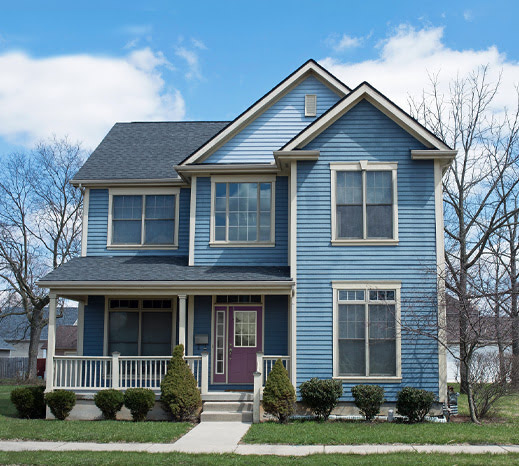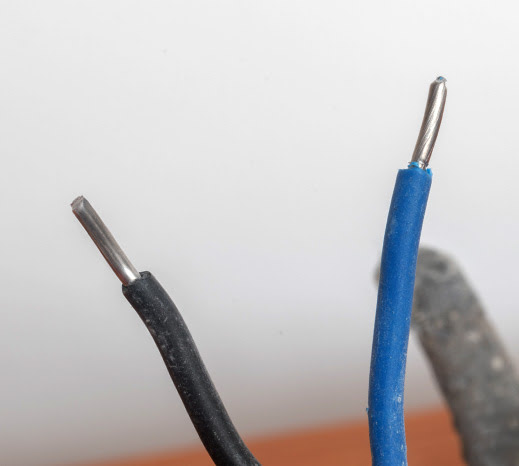The Sixties and Seventies were a time of peace and love, rock and roll, a little bit of disco and a whole lot of aluminum wiring.
If your Calgary home was built during this time period, there’s a good chance it could still have aluminum wiring hidden behind the walls. Once a popular alternative to copper, aluminum wiring hasn’t stood the test of time the way builders hoped. Today, it’s better known for its serious safety risks than its attractive cost.
So in this guide, we’ll break down why aluminum wiring was used in the first place, how to spot it in your home, and—most importantly—why replacing it is one of the smartest electrical upgrades you can make for your family’s safety and peace of mind.
4-Star Electric has been Calgary’s preferred choice for whole-home rewiring for over 35 years. Our experts evaluate your current electrical materials and install a system that protects your home and family and complies with home insurance requirements.
Let’s begin!
What is Aluminum Wiring?
If your Calgary and Area home has aluminum wiring within its walls, you may want to consider upgrading or replacing your wiring.
Aluminum was chosen as the go-to material option for wiring during the sixties and seventies, mostly due to it having a low cost of production and being extremely light weight, while still being an ok way to transmit and distribute electricity.
But it also had its drawbacks. Wiring made from aluminum can lead to accidents involving fire hazards and corrosion when not installed or maintained properly. And depending on who your insurance company is, they might not cover you until you’ve had it rewired or restored with something safer and more durable.
Contact 4-Star Electric for an electrical inspection to start the process of replacing or repairing aluminum wiring today!
How Do I Know if My Home Has Aluminum Wiring?
As we said above, but it doesn’t hurt to restate, houses that still contain aluminum wiring can be more susceptible to receiving damage caused by electrical fires and hazards.
Here’s how to tell if your home is outfitted with aluminum wiring:
- Your wires have a specific silver color that shows that they are made of aluminum. Copper wiring is a warmer, brown colour.
- Your wiring-device binding terminals have been marked CO/ALR, which stands for “copper/aluminum revised."
- The word "aluminum" or the initials "AL" are visible on your wire jackets.
- Your home was built or renovated between 1965 and 1978.
What Type of Wiring is Used in Homes Now?
In the late 1970s, homes started to primarily use copper as the industry standard for wiring. And today, most houses contain non-metallic dry (NMD) cables for their wiring system — these cables contain three different conductors protected by a plastic shell. This helps improve performance and safety.
If your home still contains aluminum wiring, you may want to consider getting your house rewired with NMD cables or installing copper tails on your existing aluminum wiring.
Repairs Using Aluminum to Copper Connectors
If your home still has aluminum wiring, but you’re unable to invest in a whole-home rewire, you can avoid the potential dangers of this material through the use of proper aluminum connectors.
One method that our electricians use to repair and connect aluminum to copper connectors is called pigtailing — this method is when a short piece of copper wire is attached to the aluminum wire using a certified aluminum to copper connector and de-ox agent. The copper wire is then connected to a termination device, such as a switch or wall outlet.
Keep in mind that pigtailing can lead to increasing the hazards presented by aluminum wiring in the first place if the connections are not completed properly with the proper materials. In other words, this is not a DIY job.
Another method that can be used to connect aluminum is CO/ALR connections. These devices can provide temporary repairs to faulty aluminum wiring, but cannot be used for all parts of your wiring system. These connections cannot complete a repair because they are unable to be used with things like ceiling-mounted light fixtures or permanently wired appliances.
Why is Aluminum Wiring Dangerous?
Aluminum wiring can frequently separate from the screws on electrical outlets, switches, or lights and create a poor connection that leads to the wire heating up. This abundance of heat can cause the aluminum to oxidize and potentially lead to an electrical fire.
Signs of Failure with Aluminum Wiring
- Flickering lights
- Warm to the touch outlets
- Frequent and recurring breaker trips
- Burning odours in and around your electrical panel or other connection points
Why is Aluminum a Bad Material For Wiring?
Aluminum is a poor conductor when used in wiring when compared to other materials because:
High Electrical Resistance
Aluminum has a relatively high resistance to electrical flow compared to copper. This means that when given the same amperage, aluminum conductors will have to be of a larger diameter than copper wires in order to produce the same amount of electricity.
Galvanic Corrosion
When aluminum is exposed to moisture it will undergo galvanic corrosion when it comes into contact with certain other metals.
Oxidation
Aluminum wiring is more easily oxidized compared to copper wiring. The compound formed by the oxidation of aluminum (aluminum oxide) is less conductive than copper oxide.
High Rate of Thermal Expansion and Contraction
Aluminum greatly expands and contracts with changes in temperature, which can cause the connections between the wiring and the device to steadily degrade in effectiveness and durability.
Less Ductile
Aluminum will fatigue and break down more easily when bent or impacted compared to copper, which is considered to be a more ductile material. By breaking down, an aluminum wire will increase its resistance to an electrical current which can lead to a buildup of excess heat.
Malleability
Aluminum is highly sensitive to compression; for example, if a screw has been over-tightened on aluminum wiring, the wire will continue to deform in the same manner even after the tightening has been undone. This creates a loose connection and increases electrical resistance.
Choose 4-Star Electric For Your Whole Home Rewire
While we mentioned repair options above, it really doesn’t compare to the benefits of a whole-home rewiring for long-term safety. So choose the experts at 4-Star Electric for all your aluminum wiring restoration and replacement needs.
We always begin with a comprehensive electrical system inspection to identify the areas within your home that contain aluminum wiring. Your personal electrician will also make notes on the overall condition of the wiring and signs of deterioration or loose connections.
You will then be given a complete title and cost breakdown for the rewiring project to ensure you know exactly what to expect.
Our replacement process is efficient, straight-forward and most importantly, safe.
The aluminum wiring is carefully removed and replaced with copper, and your electrician will ensure that all connections are properly secured and to code. They will then replace outlets and switches to ensure compatibility with your new wiring.
Once the replacement is complete your electrician will do a complete inspection to ensure quality workmanship.
When you choose 4-Star, you can have total confidence in our team. We provide the highest quality rewiring services, and we’re proud to offer industry-leading guarantees.For 35 years and counting we’ve been providing Calgary area home and business owners worry free electrical services, so give us a call today!
Frequently Asked Questions About Aluminum Wiring
How can I tell my home has aluminum wiring?
If you’re unsure of the age of your home, aluminum wiring can be identified by its colour. Aluminum is silver in hue, while copper is a yellow or rust colour. You can also look for a label on the wire jacket (outside layer). It will be marked as “AL” or “aluminum.” Our electricians can also always assess your home’s electrical and let you know what materials are used for your home’s wiring.
Will I need to rewire my whole house?
Not always. Although aluminum wiring has many safety concerns, you do not necessarily need to rewire your entire home. When properly installed, aluminum wiring is safe. But the lifetime of aluminum as a wiring material is limited to about 80 years.
It’s often only necessary to restore the section of wiring that is failing. Many home insurance providers require certain electrical restorations when you purchase a new property. Our electricians will assess your current wiring and help you make a decision about how much aluminum wiring should be restored.
How much does it cost to rewire my home?
The cost of rewiring an entire home is based on the total length of wire being replaced and the number of outlets your home has. Larger homes are more expensive to rewire.




